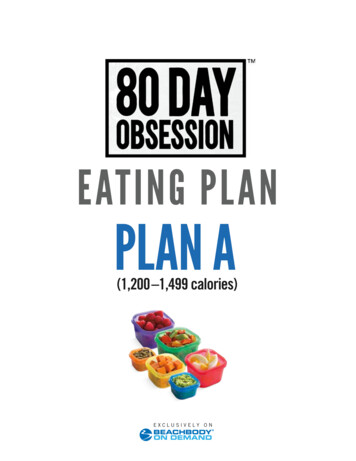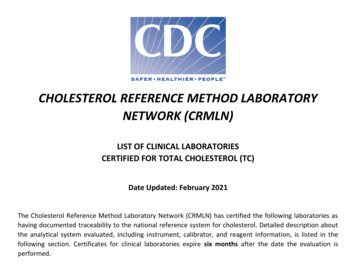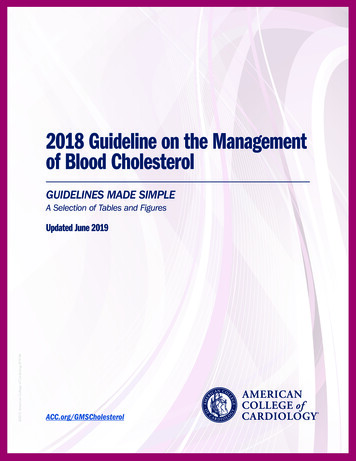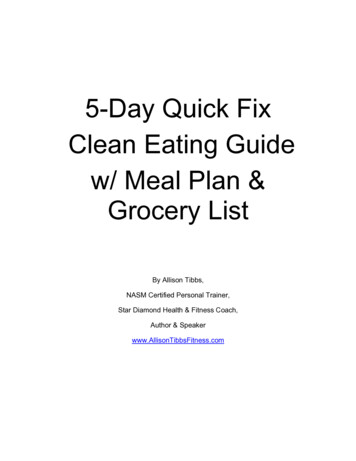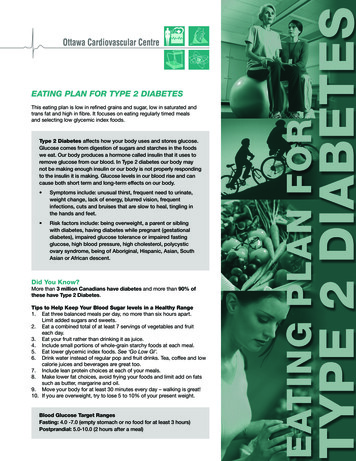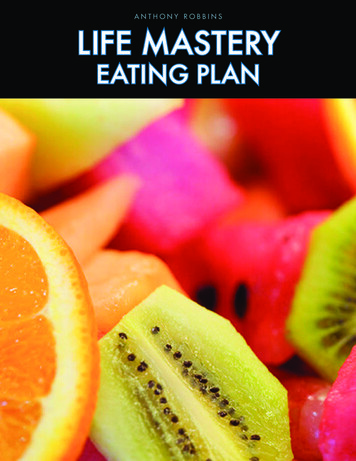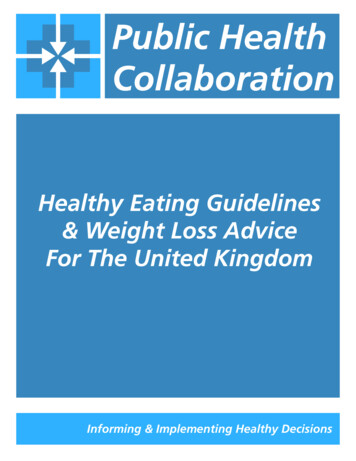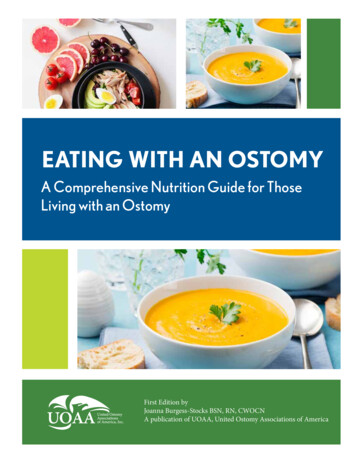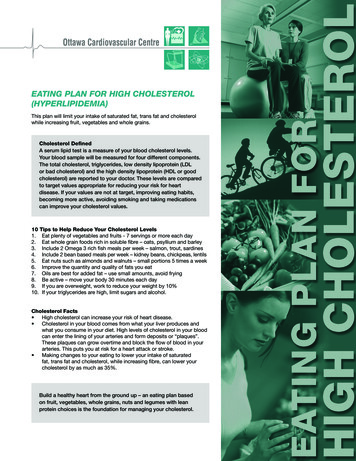
Transcription
EATING PLAN FOR HIGH CHOLESTEROL(HYPERLIPIDEMIA)This plan will limit your intake of saturated fat, trans fat and cholesterolwhile increasing fruit, vegetables and whole grains.Cholesterol DefinedA serum lipid test is a measure of your blood cholesterol levels.Your blood sample will be measured for four different components.The total cholesterol, triglycerides, low density lipoprotein (LDLor bad cholesterol) and the high density lipoprotein (HDL or goodcholesterol) are reported to your doctor. These levels are comparedto target values appropriate for reducing your risk for heartdisease. If your values are not at target, improving eating habits,becoming more active, avoiding smoking and taking medicationscan improve your cholesterol values.10 Tips to Help Reduce Your Cholesterol Levels1. Eat plenty of vegetables and fruits - 7 servings or more each day2. Eat whole grain foods rich in soluble fibre – oats, psyllium and barley3. Include 2 Omega 3 rich fish meals per week – salmon, trout, sardines4. Include 2 bean based meals per week – kidney beans, chickpeas, lentils5. Eat nuts such as almonds and walnuts – small portions 5 times a week6. Improve the quantity and quality of fats you eat7. Oils are best for added fat – use small amounts, avoid frying8. Be active – move your body 30 minutes each day9. If you are overweight, work to reduce your weight by 10%10. If your triglycerides are high, limit sugars and alcohol.Cholesterol Facts High cholesterol can increase your risk of heart disease. Cholesterol in your blood comes from what your liver produces andwhat you consume in your diet. High levels of cholesterol in your bloodcan enter the lining of your arteries and form deposits or “plaques”.These plaques can grow overtime and block the flow of blood in yourarteries. This puts you at risk for a heart attack or stroke. Making changes to your eating to lower your intake of saturatedfat, trans fat and cholesterol, while increasing fibre, can lower yourcholesterol by as much as 35%.Build a healthy heart from the ground up – an eating plan basedon fruit, vegetables, whole grains, nuts and legumes with leanprotein choices is the foundation for managing your cholesterol.
Healthier Eating Guidelines for Lowering Cholesterol Focus on Quantity and Quality of Fat–– Quantity – 1/4 to 1/3 of your calories can come from fat. This means that you can eat between 50 to 70 grams of fateach day. The number of fat grams that are right for you may be less or more than this depending on your gender,activity level and weight goals. A Registered Dietitian can help determine how much is right for you.–– Quality – unsaturated fats support a healthy cholesterol profile. These fats are liquid or soft solid at room temperature.Oils like olive oil, canola oil, soy oil and non-hydrogenated margarines are great quality fats. Use in moderation.One teaspoon of oil, the size of your thumb tip, adds 5 grams of fat.Limit saturated and trans fats, or hard fats, to 15 grams or less per day. These fats are found in full fat dairy products,meats, poultry skin, lard, palm kernel oil, hydrogenated oils and baked goods made with these fats and oils.Eat less cholesterol – aim for less than 300 mg of cholesterol per day. Cholesterol is found only animal foods.Reducing portions of meat, avoiding high fat cuts of meat and choosing lower fat dairy choices will help.Eggs – Recent studies have shown that eating an egg a day will not increase cholesterol or risk for heart disease.However, if you have diabetes you should limit your egg consumption to no more than 6 eggs per week.Nuts such as almonds, walnuts, pecans and pistachios can help lower cholesterol. Studies show 1.5 oz or about36 almonds 5 days per week helped reduce bad cholesterol. If you are working to lose weight a smaller portion of 10-12 nutsis recommended.Fibre – yes, for your heart!Fibre is found in plant based foods. Vegetables, fruit, whole grains, nuts, seeds, beans, peas and lentils are all great fibre sources.Functional or “soluble” fibre helps to reduce cholesterol by binding with cholesterol in your stomach and bowel. This cholesterolis then eliminated in your stool. Studies show we should include 10 to 25 grams of this fibre each day. Here is a list of the solublefibre foods and the grams of fibre they provide.ItemSoluble Fibre (g)ItemSoluble Fibre (g)Barley (1/2 c)1Navy Beans (1/2c)2Oatmeal (1/2 c)1Chickpeas (1/2 c)1Oat bran (1/2 c)2Carrots1Apple1Brussels Sprouts3Citrus (oranges)2Psyllium Seeds (1 Tbsp)5Pears2Metamucil (1 tsp)2Kidney Beans (1/2c)3All Bran Buds (1/3c)2Heart Health Mixture 1/3 ground flax, 1/3 oat bran, 1/3 psyllium.Use 2tbsp each day added to your food. It mixes well with yogurt, hot cereal and salad dressing.Salt – Shake the HabitTips to reduce salt (sodium) intake: Home prepared fresh or frozen foods are best. If using canned foods, look for labels such as “no added salt” or “lowsodium”. Avoid adding salt to your food and omit from recipes where possible. Season your food with herb and spice blends. Check ingredient lists to avoid those with salt. Limit condiments such as ketchup, mustard, soy sauce etc. Use Nutrition Facts Labels. Best choices have less than 200 mg sodium per serving. Avoid packaged food with more than400 mg of sodium per serving. Check labels carefully. Use ingredient lists - foods listing salt or sodium at the beginning of the list or multiple times in the list are high in salt. Restaurant foods are often high in sodium. Try to avoid fast food but do use the restaurants’ Nutrition Information toidentify lower sodium options. When eating out, ask your server if the meal can be prepared without added salt. Requestsauces on the side.
Omega-3 FatsOmega 3’s are unsaturated fats found in cold water fatty fish (salmon, mackerel, arctic char, sardines, trout and herring) and inplant foods including walnuts and flax seeds. The “fish” omega-3’s are commonly known as EPA and DHA. The “plant” omega-3’sare known as ALA. ALA is converted to EPA and DHA in your body. Food should be your first choice to achieve your omega 3’s(see below). Aim to eat 2 meals including fish each week and use the Heart Health Mixture as noted on the previous page.If you have heart disease or your triglycerides are high, your doctor or dietitian may recommend an Omega 3 supplement.OMEGA 3 CONTENT OF FOODSFish (2.5 oz)EPA/DHA (mg)per servingNuts/Seeds/OilsALA (mg) perservingEnriched FoodsTotal Omega -3(mg) per servingHerring1600Almonds (1/4 c)150Milk DHA (1 c)20Mackerel1490Wheat Germ (27 g)190Soy beverage flax700Salmon1300Canola Oil (1tsp)430Eggs DHA (2)800Sardines1050Soybeans760Omega 3 yogurt(3/4 c)500Trout870Flaxseed, ground(1Tbsp)1600Arctic Char680Tofu (3/4c)2020Tuna, white(canned)650English Walnuts (1/4 c)2300If you have High TriglyceridesIn addition to the guidelines for managing your cholesterol, you may benefit from the following recommendations: Alcohol: Men - limit to less than 2 drinks per day or 14 per week. Women – limit to 1 drink a day or 9 per week. Depending on your triglyceride level, your doctor may ask that you further reduce this amount. Sugars - reduce added sugar e.g. table sugar, syrup, jam, honey, molasses. Limit juice, pop, candies, sweets, chocolateand baked goods. If you have diabetes, work with your healthcare team to improve your blood glucose (sugar) control Omega 3 supplements – adding 2000 to 4000mg of EPA DHA from fish oil. This should be done under the supervisionof your doctor Niacin by prescription – this B vitamin may be recommended to lower your triglycerides. It also helps raise HDL (goodcholesterol)Reducing alcohol can promote weight loss and help decrease triglyceride levels.Decoding Food LabelsThe Nutrition Facts table found on the side of packaged food can help you make better foodchoices. Always check the serving size first and consider this in relation to how much of the foodyou usually eat.Look for choices with less fat, saturated fat, cholesterol and sodium. Look for choices that giveyou more fibre.Learn more about using food labels to make healthy choices on the web:Health Canada – /index-eng.phpHealthy Eating Is In Store for You – www.healthyeatingisinstore.ca
To Reduce Weight Eat smaller portions of foods and remember the balance of foods on your plate: 1/4 protein, 1/4 starch (includingpotatoes), 1/2 vegetablesEat 3 meals per day, no more than 6 hours apart. Don’t skip meals. Snack with fruit between meals.Choose foods lower in fat and sugar. Eating strategies including low glycemic index choices can be helpful.Learn more from a registered dietitian.Aim for a maximum weight loss of 1-2 lbs (0.5 -1 kg) per week.“Waist loss” is as important as weight loss. For tips on how to trim your waist see our Waisting Away nutritionfact sheet.For a more detailed plan for weight loss please read Waisting Away - Healthy Weight Management available in our clinicor on the web at www.ottawacvecntre.comPortions to Live By ne serving of whole grains is 1/2 cupOcooked, not the 3 or more cups served in mostrestaurants! Too much of a good thing is not agood thing.For more details on healthy portions seeEating Well with Canada’s Food Guide on-lineat einStarchFruitVegetablesBreakfastLunch & SupperPrepare for Success Cook without adding fat – bake, broil, roast, barbeque, grill, steamLimit pan frying and avoid deep fat fryingTry using 1/3 less fat than your recipe calls forAdd flavour to food with herbs and spices – think garllic, lemon, ginger and moreRefrigerate soups and stews and skim off fat when solidUse a spray of oil to prevent sticking and add flavourFood and Medication InteractionsReview your medications with your Doctor, Dietitian or Pharmacist. Caution with grapefruit, grapefruit juice, pomelos and Seville oranges Certain medications for cholesteroland heart disease interact with these foods.Supplements for Cholesterol ControlCheck with your Doctor, Dietitian or Pharmacist before starting a supplement. Heart Healthy Mixture 1/3 ground flax, 1/3 oat bran and 1/3 psyllium. Use 2 Tablespoons per day addedto foods or beverages. Omega 3 supplements–– if you have heart disease: 1000 mg per day as EPA DHA–– if your triglycerides are elevated: 2000 to 4000 mg per day (under the supervision of your doctor). Plant Sterols – consuming 2 grams of plant sterols per day from enriched foods, such as margarine with plantsterols, has been shown to reduce LDL cholesterol. Red yeast rice can be effective at lowering cholesterol but these products are unregulated. Their content isunreliable and therefore they are not recommended for use. Supplements of garlic, soy and lecithin do not appear to reduce cholesterol based on current research. Lecithin does not appear to reduce cholesterol. Coenzyme Q10 – evidence to date does not show that Co Q10 reduces muscle pain associated with cholesterollowering medications.
Move your body, lower your bad cholesterol, raise your good cholesterol Including at least 30 minutes of brisk activity, such as walking, four (4) or moredays per week can lower your LDL and raise your HDL.Start with a brisk 10 minute walk a few times per day and increase gradually from there.Gentle stretching exercises increase your flexibility and release tension in your muscles and joints. Aim for 4 or morestretching sessions per week.Strength exercises improve muscle and bone density keeping you strong and stable. Include these 2-4 times perweek.Remember to start slowly and consult your physician before starting a newexercise programKeeping active can lower your blood sugar, cholesterol, blood pressure, help you feel better, relieve tensionand stress, improve your muscle tone and help you lose weight!Eating Plan for High CholesterolCholesterol lowering – maximum 15 mg of saturated fat per day, 300 mg of cholesterolRead food labels for less fat, saturated fat, cholesterol and sodium and more fibre.Note: Underlined foods are commonly higher in salt (sodium) – limit use in cases of hypertension or othercondition requiring salt restriction.FOODS TO CHOOSEVegetables and Fruit Fresh and frozen are best Unsweetened canned fruit, unsalted cannedvegetables Limit fruit juice with elevated triglycerides Low sodium vegetable juice Avocados and olives in moderation for healthy fatWhole Grains bread, buns, rolls, pita bread, English muffins andtortillas low fat crackers, breadsticks, melba toast, sodacrackers (unsalted tops) Unsweetened hot or cold cereal – oats, oat bran,psyllium for soluble fibre Brown rice, barley Whole grain pasta Low fat baked goods – add oat bran, ground flax toboost fibreBeverages Water, soda water, mineral water Sugar-free soft drinks Coffee, Tea – limit to 4 cups per day Cereal beverages (e.g. Postum, Ovaltine)Milk and Alternatives Any with 1% Milk Fat (MF) or less Cheese with less than 20% MF – occasional useFOODS TO LIMIT OR AVOID Vegetables prepared with butter, cream or sauce;battered and deep friedFruit packed in heavy syrup or sugar; sweetened fruitjuice, fruit drinks, sports drinksAvoid “white” productsCheese or egg bread, croissants, sweet rollsCrackers over 5 grams of fat per serving, commercialcrumb coatingsSweetened cerealsPasta with butter, cream or cheese sauce, chow miennoodles, ramen noodlesCommercial muffins, cakes, donuts, Danish, high-fatcookies Regular tonic waterRegular soft drinks, lemonade, sweetened iced tea,regular drink crystal mixesFlavored instant coffeeLiqueurs, Cocktail mixes All milk products which are more than 1% MFCheese 21% MF or higher
FOODS TO CHOOSEFOODS TO LIMIT OR AVOIDMeat and Alternatives Fish and shellfish: fresh, frozen-unbattered, canned in water Poultry: chicken, turkey – without skin Meat: lean cuts, fat trimmed–– Beef: round, rump, sirloin, extra lean/lean ground–– Veal: round, rump, tenderloin–– Lamb: leg, loin, shank, lean ground–– Pork: tenderloin, back bacon,
what you consume in your diet. High levels of cholesterol in your blood can enter the lining of your arteries and form deposits or “plaques”. These plaques can grow overtime and block the flow of blood in your arteries. This puts you at risk for a heart attack or stroke. Making changes to your eating to lower your intake of saturated fat, trans fat and cholesterol, while increasing .
